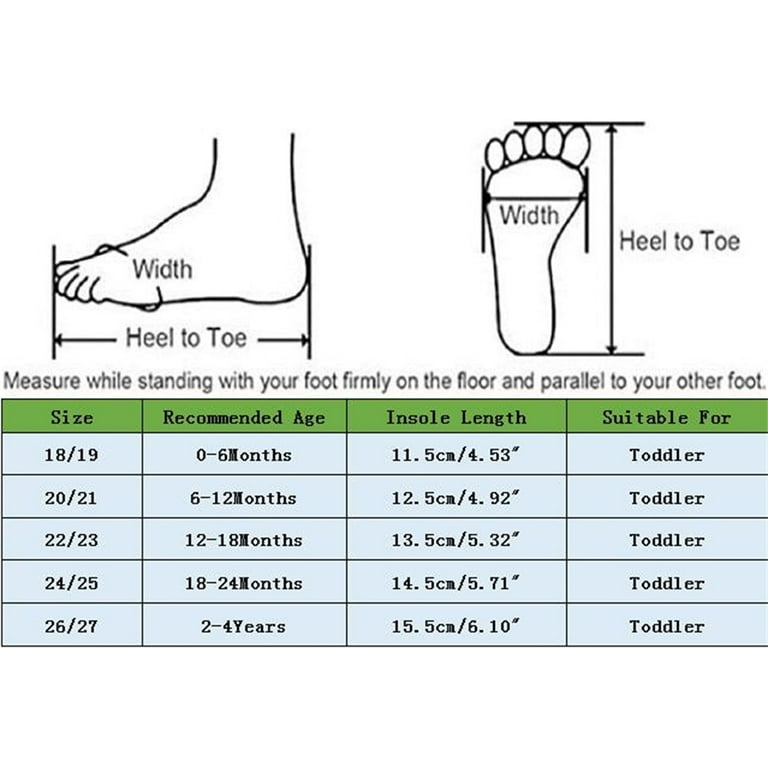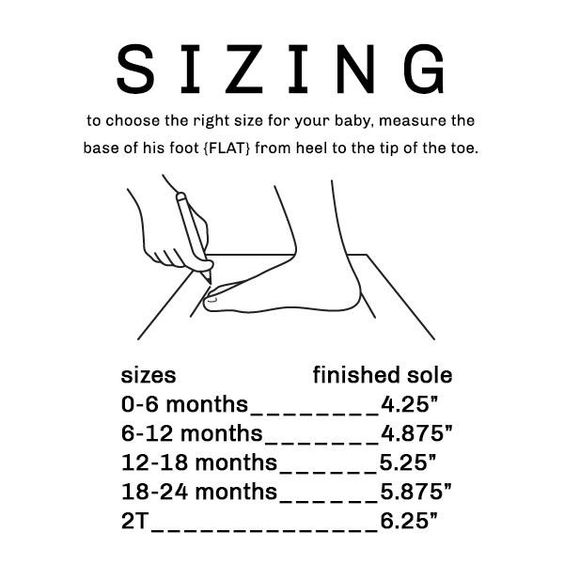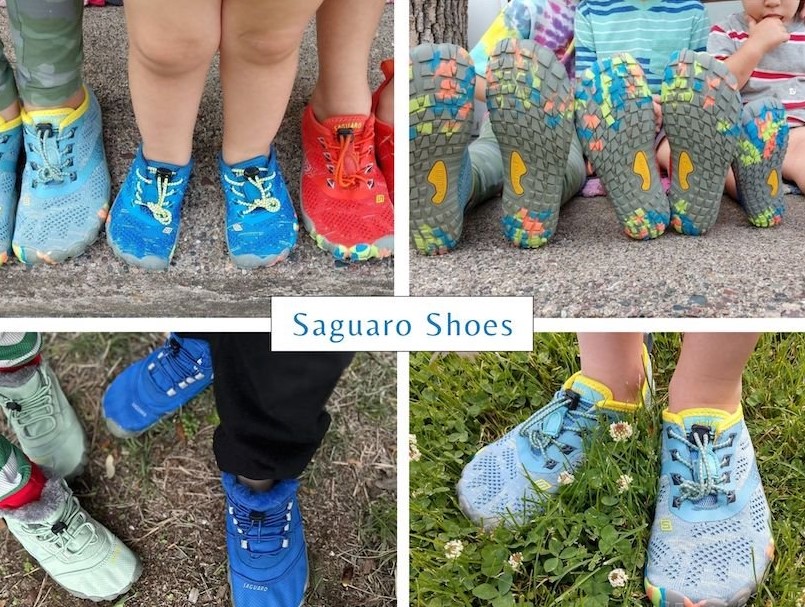To size toddler shoes, measure your child’s feet. Use a soft tape measure for accuracy.
Choosing the right shoe size for toddlers is essential for their comfort and development. Little feet grow quickly, so regular measurement is important. A proper fit helps prevent foot problems later. It also allows toddlers to walk and play freely.
Start by measuring both feet, as they may differ in size. Always choose shoes that provide good support and enough room for movement. Look for shoes with a flexible sole and breathable materials. This helps keep their feet healthy. With the right size and style, your toddler will be ready to explore the world with confidence.
Table of Contents

Credit: www.walmart.com
The Importance Of Properly Fitted Toddler Shoes
Choosing the right shoes for toddlers is crucial. Properly fitted shoes support healthy foot development. They also prevent discomfort and foot problems. Let’s explore why fitting matters.
Growth And Development
Toddlers grow quickly. Their feet change size frequently. Wearing the wrong size can hinder their growth. Here are key points to consider:
- Foot Size Changes: Measure feet every few months.
- Arch Development: Support arches as toddlers walk.
- Balance: Proper shoes improve stability and balance.
Fitting shoes correctly allows for natural foot development. Shoes should accommodate slight growth without being too tight.
Avoiding Foot Problems
Improperly fitted shoes can lead to many issues. Here are common foot problems toddlers face:
| Foot Problem | Cause | Prevention |
|---|---|---|
| Bunions | Too tight shoes | Choose wider styles |
| Blisters | Friction from ill-fitting shoes | Ensure proper sizing |
| Flat Feet | Lack of support | Opt for supportive soles |
Choosing the right size helps prevent these issues. Parents should check the fit regularly. Comfortable shoes encourage active play and exploration.
Key Considerations Before Sizing
Choosing the right size for toddler shoes is crucial. It affects comfort and foot development. Here are important factors to consider before sizing your toddler’s shoes.
Timing Of Measurements
Measuring your toddler’s feet at the right time is essential. Feet can swell throughout the day. Follow these tips for accurate measurements:
- Measure feet in the afternoon.
- Ensure your toddler is standing.
- Use a measuring tool or ruler.
Repeat measurements every few months. Toddler feet grow quickly. Regular checks help ensure a proper fit.
Understanding Toddler Foot Anatomy
Toddlers’ feet are unique. Knowing their anatomy helps in choosing shoes.
- Arch: Many toddlers have flat feet.
- Width: Feet may be narrow or wide.
- Growth plates: These areas are soft and flexible.
Good shoes support natural development. Look for options that allow room for growth. Avoid shoes that are too tight or stiff.
Tools For Measuring Toddler Feet
Measuring toddler feet correctly is essential. Proper shoe size supports their growth. Use the right tools for accurate measurements. Here are some effective methods to measure toddler feet.
At-home Methods
Measuring at home is simple. Gather a few easy tools:
- A piece of paper
- A pencil or pen
- A ruler or measuring tape
Follow these steps for accurate measurements:
- Have your toddler stand on the paper.
- Trace around their foot.
- Measure the longest distance from heel to toe.
- Repeat for both feet; use the larger measurement.
Compare the measurement with a shoe size chart. This method works well for a quick check.
Professional Fitting Services
Consider professional fitting services for best results. Experts ensure accurate sizing. Here’s what to expect:
- Trained staff measure your child’s feet.
- They assess foot width and shape.
- They recommend shoes based on fit and comfort.
Many shoe stores offer this service for free. Professional fitting helps avoid discomfort and foot problems.
Step-by-step Guide To Measuring At Home
Measuring your toddler’s feet at home is easy. Accurate measurements help you find the perfect shoe size. Follow these simple steps for a successful measurement process.
Preparing To Measure
Gather the following items:
- A piece of paper
- A pencil or pen
- A ruler or measuring tape
- Your toddler’s favorite pair of socks
Make sure your toddler is standing. This position helps get accurate measurements. It’s best to measure their feet at the end of the day. Feet tend to swell slightly during the day.
Recording Accurate Sizes
Follow these steps to measure your toddler’s feet:
- Place the paper on a flat surface.
- Have your toddler stand on the paper.
- Trace around their foot with the pencil. Keep the pencil straight and close to the foot.
- Repeat for both feet. Most toddlers have one foot larger than the other.
Once you have the tracings, measure the length:
| Measurement | Size |
|---|---|
| Length in inches | Corresponding shoe size |
| 4.5 inches | Size 5 |
| 5.0 inches | Size 6 |
| 5.5 inches | Size 7 |
Use the largest measurement for the shoe size. Remember to check the brand’s sizing chart. Different brands may have slight variations in sizing.
Interpreting Size Charts
Understanding size charts is key to finding the right toddler shoes. Each brand can have different sizing standards. Knowing how to interpret these charts will save time and ensure a better fit. Let’s dive into some important aspects of size charts.
Comparing Brands
Different brands often use unique sizing. Here are some common variations:
- Nike: Typically runs small.
- Adidas: Usually fits true to size.
- New Balance: Often offers a wider fit.
- Stride Rite: Designed specifically for toddlers.
Always check the brand’s size chart. This helps you choose the right size based on their measurements.
International Size Conversions
Toddler shoe sizes vary across countries. Here’s a simple table for reference:
| US Size | UK Size | EU Size |
|---|---|---|
| 4 | 3 | 19 |
| 5 | 4 | 20 |
| 6 | 5 | 21 |
| 7 | 6 | 22 |
Use this table to convert sizes easily. Many brands provide international size charts. Make sure to check them before purchasing.
The Role Of Socks In Sizing
Socks play a crucial part in sizing toddler shoes. They can affect the overall fit and comfort. Choosing the right socks ensures a better shoe fit. This section explores the importance of socks in toddler shoe sizing.
Choosing The Right Socks
Choosing the right socks for your toddler is essential. Consider the following points:
- Material: Soft cotton or bamboo is best.
- Thickness: Thicker socks can make shoes tighter.
- Length: Ankle or crew socks work well.
Here are some tips for selecting socks:
- Ensure socks fit snugly without being too tight.
- Choose socks with elastic tops to prevent slipping.
- Wash and dry socks to avoid shrinkage.
Impact On Shoe Fit
Socks significantly impact how shoes fit. A good fit ensures comfort and support. Here’s how socks affect shoe sizing:
| Sock Thickness | Shoe Fit Impact |
|---|---|
| Thin Socks | Looser fit, more room in shoes. |
| Medium Socks | Standard fit, ideal for most shoes. |
| Thick Socks | Tighter fit, may cause discomfort. |
Testing shoe fit with socks is essential. Have your toddler wear their socks while trying on shoes. This ensures the best fit for daily activities.
Tips For Shoe Shopping With Toddlers
Shoe shopping for toddlers can be a fun adventure. With the right approach, you can make it enjoyable for both of you. Here are some helpful tips to ensure a successful shopping trip.
Best Times To Shop
Choosing the right time can make a big difference. Toddlers can be unpredictable, so consider the following:
- Shop after naps: Well-rested toddlers are more cooperative.
- Choose a calm day: Avoid busy weekends or holidays.
- Avoid meal times: Hunger can lead to crankiness.
Plan your shopping trip during their happiest hours. This will keep both of you in good spirits.
Involving Your Toddler In The Process
Engaging your toddler can make shoe shopping more enjoyable. Here’s how to involve them:
- Let them pick: Allow your toddler to choose their favorite style.
- Use fun language: Turn the shopping trip into a game.
- Try on shoes together: Show them how to wear and remove shoes.
Encouraging their participation builds excitement. This approach can lead to better choices and a happier shopping experience.

Credit: www.pinterest.com
Assessing The Fit Of Toddler Shoes
Finding the right fit for toddler shoes is crucial. Properly fitted shoes support healthy foot development. Here’s how to assess their fit effectively.
Checking For Adequate Space
Ensure there is enough space in the shoes. Follow these steps:
- Measure the length of your toddler’s foot.
- Leave about half an inch of space at the toe.
- Check width; the shoe should not pinch the sides.
To measure foot size:
- Place your toddler’s foot on a piece of paper.
- Trace the outline of the foot.
- Measure from the heel to the longest toe.
Use the measurement to choose the correct shoe size. Each brand may fit differently. Always check the size chart before buying.
Ensuring Comfort And Support
Comfort is key for active toddlers. Follow these tips:
- Choose shoes with soft materials.
- Look for padded insoles for extra comfort.
- Ensure the heel is snug but not too tight.
Test the shoes:
- Have your toddler walk around.
- Watch for any signs of discomfort.
- Check if they can move their toes freely.
Good support helps prevent foot problems. Look for shoes with sturdy soles. This ensures safety during playtime.
Navigating Different Types Of Shoes
Choosing the right shoes for toddlers can be confusing. Different types of shoes serve various purposes. Understanding these types helps ensure comfort and safety for tiny feet.
Sneakers Vs. Sandals
Sneakers and sandals are common choices for toddlers. Each type has unique benefits.
| Feature | Sneakers | Sandals |
|---|---|---|
| Support | Good ankle and arch support | Minimal support |
| Breathability | Less breathable | Highly breathable |
| Best For | Active play | Warm weather |
| Durability | More durable | Less durable |
- Sneakers provide excellent support for running and jumping.
- Sandals keep feet cool during hot days.
Seasonal Footwear Considerations
Different seasons require different types of footwear. Choosing the right shoes for the season is important.
- Summer: Lightweight sandals are ideal. Look for adjustable straps.
- Winter: Insulated boots keep feet warm. Waterproof options are best.
- Spring: Sneakers work well for rainy days. Choose shoes with good traction.
- Fall: Ankle boots provide warmth. Ensure they fit well with socks.
Consider the weather and activities. Proper footwear keeps toddlers safe and comfortable. Happy feet lead to happy adventures!

Credit: tippytotshoes.com
When To Size Up
Knowing when to size up your toddler’s shoes is essential. Children grow quickly. Their feet need proper support and room to grow. Here are some key signs to watch for.
Signs It’s Time For A New Size
- Visible Toe Crowding: If your child’s toes touch the front.
- Foot Pain: Complaints of discomfort while wearing shoes.
- Worn-Out Soles: Check for uneven wear or holes.
- Frequent Complaints: If your child often says their shoes feel tight.
- Visible Growth: Noticeable growth spurts in other clothing.
Frequency Of Sizing Up
Children grow at different rates. Regular checks are necessary. Here’s a simple guide:
| Age | Frequency of Sizing Up |
|---|---|
| 0-1 years | Every 2-3 months |
| 1-2 years | Every 3-4 months |
| 2-3 years | Every 4-6 months |
| 3-5 years | Every 6-12 months |
Check shoes regularly. This helps ensure a proper fit. Keep your child comfortable and healthy.
Common Fitting Mistakes To Avoid
Choosing the right size for toddler shoes is crucial. Many parents make fitting mistakes. These mistakes can lead to discomfort or foot problems. Here are common fitting mistakes to avoid.
Ignoring Signs Of Discomfort
Children may not express discomfort verbally. Watch for these signs:
- Fidgeting with shoes
- Complaining about sore feet
- Refusing to wear shoes
- Red marks on skin after wear
Discomfort can indicate poor fit. Always check for:
- Enough room at the toe.
- Secure fit at the heel.
- Comfortable material without pressure points.
Try shoes on both feet. One foot may be larger. Let your child walk in them. Ensure they move comfortably.
Relying Solely On Age For Size
Children grow at different rates. Don’t assume age dictates shoe size. Use the following tips:
- Measure feet regularly.
- Use a foot measuring device or ruler.
- Refer to size charts from brands.
Remember, sizes vary by brand. A size 6 in one brand may differ from another. Always check the size guide.
Let your child try on shoes before buying. A proper fit is key for healthy foot development.
Caring For Toddler Shoes
Caring for toddler shoes ensures comfort and longevity. Proper maintenance keeps them looking new. This helps your little one move freely and safely.
Maintenance Tips
- Clean Regularly: Wipe shoes with a damp cloth. Remove dirt after every wear.
- Dry Properly: Air-dry shoes. Avoid direct sunlight to prevent damage.
- Use Protective Spray: Apply water-repellent spray. Protects against spills and stains.
- Inspect Often: Check for wear and tear. Look at soles and stitching.
- Store Safely: Keep shoes in a cool, dry place. Use a shoe box or rack.
Longevity And Upcycling
Extend the life of toddler shoes with smart choices. Upcycling transforms old shoes into new treasures.
Consider these ideas for longevity:
- Choose Quality: Invest in well-made shoes. They last longer and offer better support.
- Rotate Shoes: Use different pairs. This helps each pair recover its shape.
- Repair Damage: Fix minor issues quickly. Replace laces and patch small holes.
Upcycling options include:
- Art Projects: Turn shoes into planters or art displays.
- Donation: Give them to someone in need.
- Reselling: Sell gently used shoes online.
Empowering Toddlers Through Choice
Empowering toddlers through choice builds confidence and independence. Choosing shoes becomes an exciting adventure. Letting them decide fosters their sense of autonomy. This engagement helps them express their personality. Here’s how you can encourage this growth.
Encouraging Independence
Independence is crucial for toddlers. Allow them to pick their shoes. This simple act boosts their self-esteem.
- Offer two or three options.
- Let them try on different styles.
- Encourage them to walk in the shoes.
As they choose, celebrate their decisions. Praise their style and assertiveness. This encourages them to make choices confidently.
Fostering Style And Preference
Every toddler has unique tastes. Allow them to showcase their style. Shoes can reflect their personality.
| Style | Personality Trait |
|---|---|
| Bright Colors | Playful and Fun |
| Animal Prints | Adventurous |
| Classic Sneakers | Trendy |
Engage in conversations about their favorites. Ask questions about colors and designs. This interaction strengthens their decision-making skills.
- Discuss different shoe types.
- Encourage them to mix and match outfits.
- Respect their choices, even if different from yours.
Empower toddlers by letting them express themselves through shoes. This makes the shoe-wearing experience enjoyable.
Frequently Asked Questions
How Do I Measure My Toddler’s Feet?
Use a ruler or measuring tape. Measure from the heel to the longest toe for accurate sizing.
What Size Shoe Does A Toddler Wear?
Toddler shoe sizes typically range from 4 to 10, depending on age and foot growth.
How Often Should I Check Toddler Shoe Size?
Check every 2 to 3 months, as toddlers’ feet grow rapidly during this stage.
What Is The Best Way To Fit Toddler Shoes?
Ensure there’s a thumb’s width of space at the toe and the heel fits snugly without slipping.
Conclusion
Choosing the right size for toddler shoes is essential. Proper fitting shoes support healthy foot development. Always measure your child’s feet before buying. Remember to check for comfort and room to grow. Happy shoe shopping will keep your little one comfortable and active as they explore the world!







